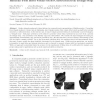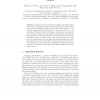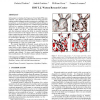286 search results - page 54 / 58 » Modelling with implicit surfaces that interpolate |
JCST
2010
13 years 8 months ago
2010
Surface triangle meshes and volume data are two commonly used representations of digital geometry. Converting from triangle meshes to volume data is challenging, since triangle mes...
ISVC
2009
Springer
14 years 4 months ago
2009
Springer
Modeling, characterization and analysis of biological shapes and forms are important in many computational biology studies. Shape representation challenges span the spectrum from s...
SIGGRAPH
1998
ACM
14 years 1 months ago
1998
ACM
In this paper we introduce the Progressive Forest Split (PFS) representation, a new adaptive refinement scheme for storing and transmitting manifold triangular meshes in progress...
VVS
1995
IEEE
14 years 1 months ago
1995
IEEE
We introduce a framework for texturing volumetric objects with displacement maps and texture maps, which are introduced as volume modeling tools. In this framework, an implicit-to...
SI3D
2005
ACM
14 years 3 months ago
2005
ACM
Blendshapes (linear shape interpolation models) are perhaps the most commonly employed technique in facial animation practice. A major problem in creating blendshape animation is ...



